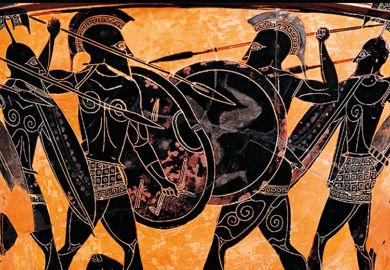Some women seem to live on the edges of other people’s stories. They duck in and out of history, apparently in the middle of things, yet eluding further scrutiny. Eva Palmer Sikelianos (1874-1952), an American heiress, is one of these well-connected yet strangely invisible women. It was partly her choice to exist on the margins, because she challenged cultural convention and championed a different mode of life. Yet she has also been deliberately marginalised, not least to promote the legacy of her husband, the influential Greek poet Angelos Sikelianos. Using previously unavailable archival material, Artemis Leontis has placed Eva back at the centre of her own story and uncovered her significant contributions to modernism and Greek culture.
The book is structured around five broad themes, organised roughly chronologically. Each covers a different area where Eva focused her energies at various times. Leontis deftly explores her involvement in Natalie Barney’s Sapphic movement; her weaving to recreate ancient Greek costume, which she habitually wore for most of her life; her deep dive into Byzantine music, becoming the first woman to be awarded the title of “Master of Byzantine Music” by the Greek Orthodox Church; her productions of Greek drama, seeking to recreate an ancient authenticity in movement and music; and her transition to political activism towards the end of her life, attempting to shift US foreign policy concerning her adopted homeland during the Second World War and its aftermath.
Leontis’ great achievement is to make a whole of Eva’s fragmented life. Such fragmentation comes in part from the evidence, as Eva’s maiden name has conveniently obscured her queerness. In the sources associated with Barney she appears as Eva Palmer, leaving the respectable reputation of Eva Sikelianos untouched.
Eva’s commitment to the cultures of ancient and modern Greece led her to make a number of extraordinary decisions, some more successful than others. Her commitment to wearing her own homespun clothes in the Greek style not only created beautiful garments for her dramatic productions, but also made a critical contribution to what we would now call experimental archaeology. Her engagement with the Greek musical tradition and images from ancient vase paintings created a form of choreography that has made an immense, if thus far unacknowledged, impact on modern dance and interpretations of Greek tragedy. Yet the same passionate devotion led her to fund a quixotic project to build a single model of a new organ suitable for the modes of Byzantine music (in place of Western keyboard tuning) and she never recovered financially from her decision to mortgage her houses in Sikya and Delphi to fund the first revival of the Delphic Festival in 1927.
Some areas of Eva’s life remain elusive; the difficulties of her marriage with Angelos are only alluded to, and her motivations for returning to the US alone in the 1930s are not entirely clear. But this reflects my desire for more personal details rather than a failing of the book - Leontis keeps her focus firmly on Eva’s intellectual life and influence, which is as it should be. This is a powerful reclamation of a life it has suited others to place in the shadows, and a well-deserved appreciation of Eva’s own legacy.
Liz Gloyn is a senior lecturer in Classics at Royal Holloway, University of London. Her book on classical monsters in contemporary culture will be published later this year.
Eva Palmer Sikelianos: A Life in Ruins
By Artemis Leontis
Princeton University Press, 392pp, £27.00
ISBN 9780691171722
Published 26 March 2019
POSTSCRIPT:
Print headline: Sculpted form of a Hellenophile
Register to continue
Why register?
- Registration is free and only takes a moment
- Once registered, you can read 3 articles a month
- Sign up for our newsletter
Subscribe
Or subscribe for unlimited access to:
- Unlimited access to news, views, insights & reviews
- Digital editions
- Digital access to THE’s university and college rankings analysis
Already registered or a current subscriber?








